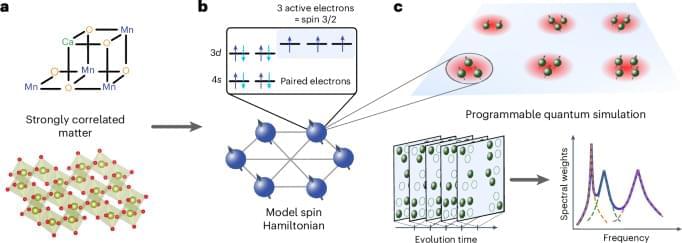Little powerhouses might someday replace billion-dollar, kilometer-long behemoths at major x-ray facilities.
“This process is like a cosmic CT scan, where we can look through different slices of cosmic history and track how matter clumped together at different epochs,” team co-leader Mathew Madhavacheril of the University of Pennsylvania said in a statement. “It gives us a direct look into how the gravitational influence of matter changed over billions of years.”
In order for the team to build this so-called CT scan of the universe, they needed to turn to light that has existed almost as long as the cosmos itself.
With such ancient light, it’s possible to track the changes the universe underwent as gravity reshaped it over around 13.8 billion years.
In a ground-breaking theoretical study, two physicists have identified a new class of quasiparticle called the paraparticle. Their calculations suggest that paraparticles exhibit quantum properties that are fundamentally different from those of familiar bosons and fermions, such as photons and electrons respectively.
Using advanced mathematical techniques, Kaden Hazzard at Rice University in the US and his former graduate student Zhiyuan Wang, now at the Max Planck Institute of Quantum Optics in Germany, have meticulously analysed the mathematical properties of paraparticles and proposed a real physical system that could exhibit paraparticle behaviour.
“Our main finding is that it is possible for particles to have exchange statistics different from those of fermions or bosons, while still satisfying the important physical principles of locality and causality,” Hazzard explains.
The CEO of Anthropic, Dario Amodei, anticipates that within the next two to three years, AI models will exceed human capabilities in most tasks. This transformative change will make AI indispensable in workplaces and as personal assistants, allowing humans to focus solely on tasks AI can’t manage, promising up to tenfold productivity increases.
For example, to compute the magnetic susceptibility, we simply select the operator \(A=\beta {({S}^{z})}^{2}\), where β = 1/T is the inverse temperature. Interestingly, this method of estimating thermal expectation values is insensitive to uniform spectral broadening of each peak, due to a cancellation between the numerator and denominator (see discussion resulting in equation (S69) in Supplementary Information). However, it is highly sensitive to noise at low ω, which is exponentially amplified by e−βω. To address this, we estimate the SNR for each DA(ω) independently and zero-out all points with SNR below three times the average SNR. This potentially introduces some bias by eliminating peaks with low signal but ensures that the effects of shot noise are well controlled.
To quantify the effect of noise on the engineered time dynamics, we simulate a microscopic error model by applying a local depolarizing channel with an error probability p at each gate. This results in a decay of the obtained signals for the correlator \({D}_{R}^{A}(t)\). The rate of the exponential decay grows roughly linearly with the weight of the measured operators (Extended Data Fig. 2). This scaling with operator weight can be captured by instead applying a single depolarizing channel at the end of the time evolution, with a per-site error probability of γt with an effective noise rate γ. This effective γ also scales roughly linear as a function of the single-qubit error rate per gate p (Extended Data Fig. 2).
Quantum simulations are constrained by the required number of samples and the simulation time needed to reach a certain target accuracy. These factors are crucial for determining the size of Hamiltonians that can be accessed for particular quantum hardware.
Without the French interpreter so you can listen through the whole speech without interruption.
Twitter… @thebrynnium.
This is Philip K Dick’s famous Metz speech given in Metz, France in 1977. Philip gave the speech with a French interpreter beside him for the audience, but for English speakers it can be distracting. I took care of that for you in addition to very subtly improving the video quality and doing modest touch-ups to the audio, making it clearer and reducing the humming without too heavy a hand. In the speech he explores some of his ideas of parallel realities (lateral realities/lateral dimensions), his experience in 1974 (2−3−74), and how they both relate to his novels. A very exciting way to get introduced to the enigmatic, fascinating Philip K. Dick!
Gaming stuff I do:
👵
Granny Reacts:
https://www.youtube.com/playlist?list=PLodjGWCq3S3ngFnDJ5lSvg5Ty8Jn8z9e3
Granny Games:
An artificial intelligence model has created a new protein that researchers say would have taken 500 million years to evolve in nature — if nature were capable of producing such a thing.
Can you trust your senses? Do animals have morals? Is your mind deceiving you?
Find out in BRAIN JOB: Perception, where we explore mind-bending phenomena like change blindness, the Trolley Problem, time travel, and more.
Thanks to museum of illusions chicago.
For more, check out.
clareruddy.com.
IG ➤ https://www.instagram.com/clare.ruddy/
TikTok ➤ https://www.tiktok.com/@clare.ruddy?lang=en.
#psychology #experiment #science #braingames #riddles #funfacts #neuoroscience #neurology #socialexperiment #sociology #timetravel #doctor #documentary #illusion #opticalillusion #interestingfacts #lifehacks #vsauce #billnye #MindBlowingFacts #CognitiveScience #LearningMadeFun #BrainPower #MindTricks #BrainFacts #MentalHealth #HumanMind #FunLearning #BrainHack #Edutainment #MemoryTricks #perception #memory #conformity #attraction #millk #LogicPuzzles #BrainTeasers #makesyouthink
China introduces its breakthrough DeepSeek R1 AI model as well as the most humanlike movement of potentially any robot so far with the AGI Bot A2 with BridgeDP Robotics, plus Chinese company Lumos showcases a stress test video of its LUS1 humanoid robot. Finally, ByteDance releases UI-TARS to compete with OpenAI’s Orchestrator agentic AI for autonomous GUI task execution.
GENERATIVE AI SPECIALIZATION: https://imp.i384100.net/START-HERE
AI Marketplace: https://taimine.com/
Atlantis by Audionautix is licensed under a Creative Commons Attribution 4.0 license. https://creativecommons.org/licenses/.… news timestamps: 0:00 BridgeDP & AGI Bot A2 3:52 DeepSeek R1 4:36 Lumos LUS1 5:31 UI-TARS agentic AI #ai #robot #technology.
AI news timestamps:
0:00 BridgeDP & AGI Bot A2
3:52 DeepSeek R1
4:36 Lumos LUS1
5:31 UI-TARS agentic AI
#ai #robot #technology
Mathematics and physics have long been regarded as the ultimate languages of the universe, but what if their structure resembles something much closer to home: our spoken and written languages? A recent study suggests that the mathematical equations used to describe physical laws follow a surprising pattern—a pattern that aligns with Zipf’s law, a principle from linguistics.
This discovery could reshape our understanding of how we conceptualize the universe and even how our brains work. Let’s explore the intriguing connection between the language of mathematics and the physical world.
What Is Zipf’s Law?









